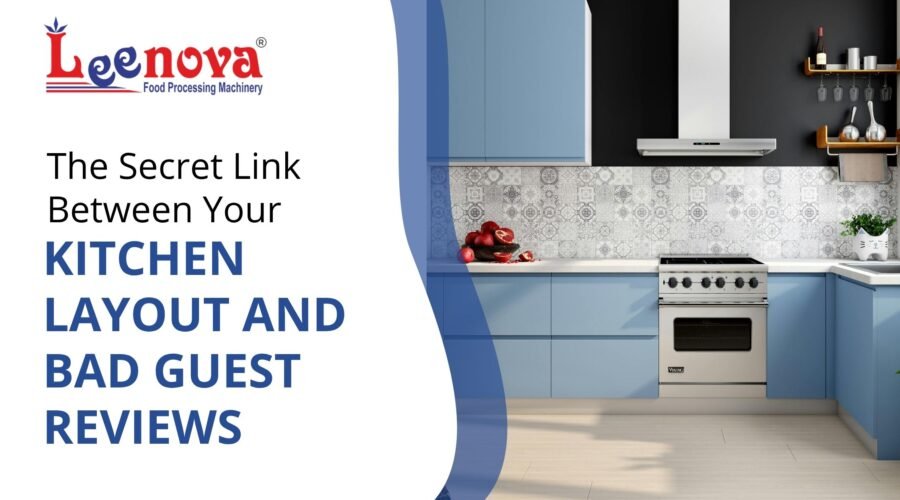The Invisible Saboteur: Why Guests Review the Kitchen Without Ever Seeing It
You’ll never see it in the review, but it’s always there — lurking behind every one-star rating about slow service, cold food, or chaotic staff behavior. The real culprit? Often, it’s not the food. It’s the layout of the kitchen.
In 2019, restaurant analytics firm SevenRooms reported that 72% of negative dining reviews mentioned slow service as a top grievance. Yet, when interviewed, over 40% of chefs and restaurant managers admitted that layout inefficiencies—not staffing issues—were to blame. The guests don’t see the kitchen, but they feel it in every delayed plate and every distracted server.
This is the great irony of hospitality: a guest might rave about decor, wine lists, or even the restroom fragrance, but if your kitchen’s workflow resembles a chaotic school play, your reviews will scream it out loud. “The food was good… but the wait was forever,” is just another way of saying your mise-en-place was misaligned.
Kitchens that look clean to the eye might still be bottlenecks to service. What’s often missing is the functional choreography that only a thoughtful layout—backed by purpose-built equipment—can provide. And that’s not just a design problem. That’s a business-killing problem.
From Fire to Frustration: How Inefficient Layouts Create Tangible Service Pain
Let’s get specific. Consider a typical commercial kitchen that uses a linear layout—prep area at one end, cooking stations in the middle, and plating near the pass. It’s a common setup. Now throw in a peak hour on a Sunday brunch. Orders start flying in. Your staff starts crisscrossing each other, sauces spill, trays jam doorways, and every extra step adds seconds. Seconds become minutes. And minutes become poor reviews.
According to a 2022 study by the Cornell School of Hotel Administration, “Even minor design inefficiencies, such as a 5-foot misplacement of a prep table, can cause up to 11% more steps per order and 9% slower plating time during peak hours.”
You’re not just losing time. You’re losing energy, morale, and—most importantly—perceived quality. It doesn’t matter that your chef prepared the perfect ghee roast. If it hits the table lukewarm, it might as well be a microwave meal.
Kitchen inefficiency is the slow leak that sinks the ship. It leads to burned-out staff, unpredictable meal timings, and ultimately a crumbling reputation. And while most entrepreneurs obsess over menu engineering, few give layout the same rigorous scrutiny. That’s like designing a race car without caring about the track.
The Domino Effect: How One Bad Equipment Placement Can Tank Table Service
There’s a reason Michelin-starred restaurants treat layout as sacred geometry. Every station has its own gravitational pull. Shift one element out of sync, and the entire system collapses like a poorly shuffled Rubik’s Cube.
In real-world kitchens, the most common design crimes include:
- Placing the dough kneading machine too far from the prep counter, leading to wasted motion.
- Positioning hot equipment near cold storage, forcing compressors to overwork and staff to overheat.
- Using household-grade machines for commercial output, which slows down processing speed and causes breakdowns.
Leenova’s research with several Indian mid-scale restaurants revealed a shocking pattern: kitchens using domestic or poorly-sized machines suffered 32% more downtime and 20% slower ticket clearance than those with professionally designed workflows and Leenova-grade units.
As one Delhi-based chef bluntly put it, “It’s not the cook who’s slow—it’s the walk from the chopping board to the fryer that kills me.”
Wait Time is Reputation Time: Kitchen Bottlenecks and Customer Psychology
Here’s the dark art of delay: Every additional minute after ordering increases perceived dissatisfaction by 6%. That’s not just a number—it’s a psychological penalty box.
In behavioral economics, this is called temporal discounting. When wait time increases, people value the product less—regardless of quality. A 2021 UK study found that even a 3-minute delay in food service dropped overall meal satisfaction scores by 14%.
Add to that the social feedback loop of online reviews, and you’ve got a time bomb. One lukewarm dosa or delayed thali leads to a review, and that review influences hundreds more potential guests. And here’s the kicker: most of those complaints trace back to backstage missteps.
A Harvard Business Review article on restaurant operations emphasized, “Layout affects labor efficiency more than any scheduling software ever could. Fix the floor first.”
The next time a customer complains about their meal taking too long, don’t just blame the staff or the crowd. Check your fryer’s location. Audit your chopping flow. Count the footsteps. That’s where the real review begins.
The Science of Flow: How Smart Kitchen Zoning Translates to 5-Star Experiences
Good kitchen layout isn’t guesswork—it’s science. The theory of “kitchen flow” comes from systems engineering, where motion economy and spatial logistics play a huge role in output efficiency.
Zoning is the foundational strategy. It means assigning specific areas for receiving, storage, prep, cooking, plating, and cleaning. When done right, each zone interacts with the next like cogs in a well-oiled machine.
What does that look like in practice?
Take the Leenova Pasta-Making Machine as an example. When integrated into a proper layout:
- It reduces handling time by 40% because ingredients don’t need to be shuffled across zones.
- It cuts down cleaning disruption by containing mess within one zone.
- It improves staff rhythm, leading to better teamwork and faster delivery.
Think of it this way: your kitchen is a factory, and flow is your assembly line. Every tool must serve not just the dish but the dance.
Equipment is Layout: Why the Right Machine in the Wrong Place is Still Wrong
Many first-time entrepreneurs make a fatal mistake—they invest in good equipment but ignore its placement. This is like buying a high-end espresso machine and putting it next to the mop sink.
Here’s what most kitchens get wrong:
- Under-bench refrigerators installed away from prep counters.
- Grinders placed in corridors, causing blockages during rush hour.
- Halwa machines shoved into corners, turning staff into gymnasts.
A well-laid-out kitchen uses equipment not just as a function, but as a form of flow control. It’s about integration, not possession.
At Leenova, we often advise clients to design layouts around equipment capabilities—not the other way around. Because a machine that can make 10 kilos of dough an hour means nothing if it takes 20 minutes to get the dough to the stove.
Real-World Case Patterns: What the Worst-Reviewed Kitchens Have in Common
Let’s talk pattern recognition. After auditing over 80 restaurants across five Indian states, the most common red flags in kitchens with poor guest reviews were:
- Crisscrossed movement paths that led to frequent collisions.
- Multi-use prep stations causing hygiene lapses.
- Long-distance plating areas resulting in cold meals.
In contrast, kitchens with better reviews and higher guest retention all shared three key traits:
- Clear zoning with minimal cross-traffic.
- Equipment scaled to kitchen volume (not just menu complexity).
- Smart integration of tools like vegetable cutters, roti makers, and fryers—all from a single ecosystem.
Here’s a zinger for you: A restaurant with a perfect menu and a bad kitchen layout is like a five-star hotel with no parking.
Leenova’s Law: Layout Intelligence + Equipment Optimization = Guest Delight
At Leenova, we coined a simple maxim: You don’t just buy machines, you buy momentum.
This philosophy has guided installations in over 500 kitchens, where our team works not just as suppliers, but as kitchen choreographers. We’ve seen firsthand how layout intelligence—matched with modular equipment—can slash cook times by 30%, reduce staff burnout, and increase table turnover.
When one Rajkot-based café redesigned their kitchen using Leenova’s advisory and installed our multi-utility cutting machine, their average service time dropped from 22 minutes to 12.5 minutes. Within 3 months, their Zomato rating jumped from 3.8 to 4.3.
We don’t sell machines. We engineer tempo.
Before the Bad Review: Conducting a Proactive Kitchen Audit
Prevention beats reputation damage. The smartest restaurateurs audit their kitchens the same way investors audit spreadsheets.
Here’s a skimmable checklist to start:
Ask:
- Are movement paths overlapping?
- Do prep and plating stations share tools?
- How many seconds does it take to transfer food from fryer to plating?
Observe:
- Any equipment that’s unused or constantly moved around?
- Do chefs seem to wait more than they work?
- Is there a rhythm or chaos in your kitchen?
Once you spot the friction points, treat them like leaks in a pipeline. Every inefficiency is a lost rupee—and eventually, a lost review.
Pro tip: Invite your equipment supplier into this audit. At Leenova, we offer layout optimization as a service—not just a sales pitch. Because we believe that a kitchen without flow is a dining room without joy.
Conclusion: Design Like It’s Rated — Because It Is
Guest reviews may never mention your pasta machine, your prep station, or the precise distance between your tandoor and your counter. But every plate, every pause, every “sorry for the delay” stems from what happens behind the scenes.
Layout isn’t luxury. It’s leverage.
So before you fix your prices, tweak your menu, or hire new staff—walk through your kitchen. Count the steps. Feel the friction. And then ask yourself:
Is your layout designed to impress your guests—or to slow down your team?
Because the review isn’t just about the food. It’s about the flow. And the kitchen always speaks—even when the door is closed.


